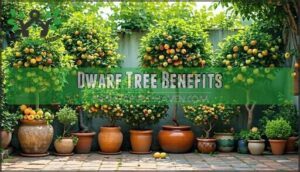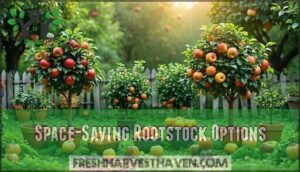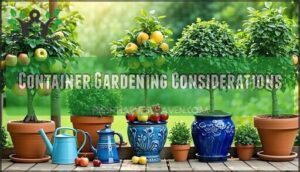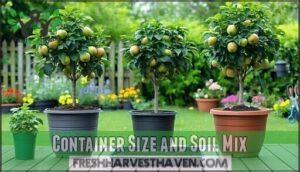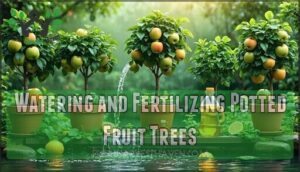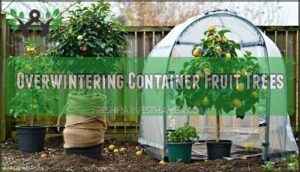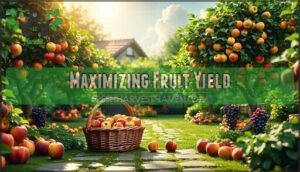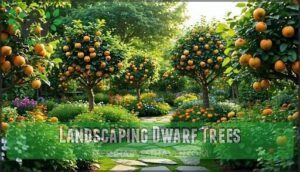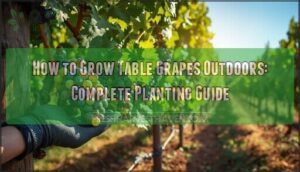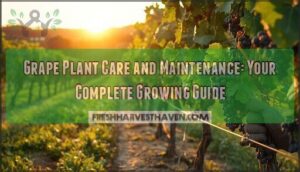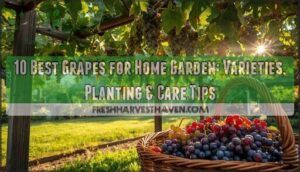This site is supported by our readers. We may earn a commission, at no cost to you, if you purchase through links.
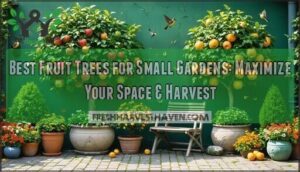
These compact champions deliver full-sized harvests in just 6-8 feet of space. Dwarf apple trees like ‘Honeycrisp’ produce 50+ pounds annually while fitting perfectly on patios.
Citrus trees thrive in containers year-round, while columnar varieties grow up instead of out. Stone fruits like peaches and plums also come in space-saving forms.
Modern rootstock technology has revolutionized small-space growing, letting you enjoy fresh fruit without sacrificing your entire yard. The secret lies in understanding which varieties work best for your specific climate and growing conditions.
Table Of Contents
- Key Takeaways
- Choosing Dwarf Trees
- Space Saving Options
- Growing Fruit Containers
- Maximizing Fruit Yield
- Landscaping Dwarf Trees
- Frequently Asked Questions (FAQs)
- What is the best fruit tree to grow in a small garden?
- What fruit trees grow in small spaces?
- What is the best fruit tree for a small garden?
- What is the easiest fruit tree to grow?
- Which fruit tree stays small?
- What fruit trees have the least invasive roots?
- What fruit tree to plant in a small garden?
- What is the lowest maintenance fruit tree?
- What is the easiest fruit bearing tree to grow?
- What fruit tree doesn’t grow big?
- Conclusion
Key Takeaways
- You’ll maximize harvest potential by choosing dwarf varieties that produce full-sized fruit while staying 6-10 feet tall, perfect for small yards and patios.
- Container growing opens up endless possibilities – you can grow citrus, stone fruits, and even exotic varieties in 20+ gallon pots that move with your needs.
- Smart rootstock selection determines your success – options like M27 apple rootstock and Flying Dragon citrus rootstock keep trees compact while maintaining productivity.
- You’ll need proper care techniques including strategic pruning, adequate pollination planning, and year-round pest management to maximize yields in tight spaces.
Choosing Dwarf Trees
When you’re short on space but long on fruit tree dreams, dwarf varieties are your garden’s best friend.
These compact champions deliver full-sized harvests while fitting perfectly into small yards, patios, or even containers.
Apple Trees for Small Gardens
Dwarf apple trees transform small garden spaces into productive backyard orchards, reaching just 8-10 feet tall while delivering full-sized fruit.
Transform your tiny yard into a fruitful paradise with compact trees that deliver big harvests.
Popular varieties like ‘Gala’, ‘Honeycrisp’, and ‘Fuji’ offer exceptional Tree Selection for compact fruit trees.
These small garden trees begin producing within 2-3 years, requiring 50% less pruning than standard trees.
Proper Apple Care includes staking for support and cross-pollination strategies to maximize Fruit Production and create stunning Garden Design.
Citrus Trees for Patios
Several citrus varieties thrive in containers, transforming your patio into a fragrant oasis.
Dwarf Meyer lemons grow 4-6 feet tall, producing sweet, aromatic fruit year-round with proper citrus care.
Calamondin oranges offer self-pollinating convenience for small space gardening.
These patio fruit trees need well-draining soil, consistent watering, and protection from frost.
Container gardening allows you to move trees indoors during winter, ensuring reliable fruit harvest despite climate challenges.
Stone Fruit Trees for Tight Spots
Stone fruits transform tight garden corners into productive havens.
These dwarf fruit trees deliver full-sized harvests without demanding excessive real estate, making small space gardening achievable for any homeowner.
- Bonanza Patio Peach: 4-6 feet tall with juicy summer peaches requiring minimal Peach Care
- Stella Cherry: Self-pollinating variety among premium Cherry Varieties reaching 10 feet maximum
- Belle of Georgia Peach: Heirloom stone fruits producing sweet white peaches with rose blush
- Damson Plum: Self-fertile option simplifying Plum Selection for single-tree gardens
These compact garden trees thrive in containers, perfect for patio fruit trees where space constraints challenge traditional orchards.
Exotic Fruit Trees for Limited Areas
Beyond traditional orchards, tropical fruits offer exciting possibilities for compact spaces.
Dwarf mangoes reach just 4-6 feet, while mini bananas thrive in containers at similar heights.
Exotic pomegranates and compact guavas adapt beautifully to small yard trees, bringing Mediterranean flair to your space.
These miniature fruit trees transform patios into tropical paradises, proving you don’t need acres for exotic harvests.
Space Saving Options
When you’re working with limited square footage, smart space-saving strategies can help you squeeze maximum fruit production from every available inch.
Modern dwarf rootstock technology and container growing techniques transform even the smallest patios into productive mini-orchards that rival traditional gardens.
Dwarf Tree Benefits
With dwarf fruit trees, you’re getting all the benefits without the burden of towering giants hogging your yard.
These compact trees deliver full-sized fruit quality while requiring minimal space – perfect for small garden design.
Their low maintenance nature and aesthetic value make them ideal patio trees that won’t overwhelm your landscape yet still provide abundant harvests.
For successful cultivation, understanding dwarf tree care is essential to maximize yields.
Space-Saving Rootstock Options
Your rootstock selection determines your tree’s final size and performance.
Professional grafting methods combine productive fruit varieties with dwarfing rootstocks, creating compact trees perfect for small spaces.
- M27 apple rootstock – Reduces tree height to 6-8 feet while maintaining full-sized fruit production
- Flying Dragon citrus rootstock – Creates cold-hardy, space-efficient citrus trees ideal for containers
- Pixy stone fruit rootstock – Controls peach and plum growth for tight garden spots
When planning a small garden, understanding small space gardening techniques is vital for maximizing yields and maintaining healthy plants.
Container Gardening Considerations
Container gardening opens up possibilities for growing dwarf fruit trees in small gardens where ground space is limited.
Pot size directly impacts root development and fruit production—choose containers at least 20 gallons for most compact trees.
Soil quality matters tremendously; use well-draining potting mix designed for container gardening.
Water management becomes your biggest challenge since containers dry out faster than ground soil.
Root care includes regular repotting every 2-3 years to prevent becoming rootbound.
Container materials like ceramic or wood provide better insulation than plastic for space-saving cultivation success.
Growing Fruit Containers
Container gardening transforms any small space into a productive fruit-growing area, even if you don’t have soil to plant in.
You’ll need to choose the right varieties, containers, and care techniques to guarantee your potted fruit trees thrive and produce abundant harvests.
Best Varieties for Pots
You’ll find success with specific varieties that thrive in containers.
Potted apples like ‘Pixie Crunch’ and ‘Garden Delicious’ consistently deliver excellent harvests.
Mini citrus trees including ‘Improved Meyer Lemon’ produce fragrant blooms and tangy fruit.
Dwarf peaches such as ‘Pix Zee’ and compact figs like ‘Petite Negra’ adapt beautifully to pot life.
Small pomegranates including ‘Nana’ complete your container-grown fruit tree collection perfectly, with fragrant blooms.
Container Size and Soil Mix
Your choice in pot size directly impacts your tree’s health and productivity.
Select containers at least 20 gallons for most dwarf varieties, guaranteeing adequate container depth for root development.
Create well-drained soil using a mix of quality potting soil, compost, and perlite.
Proper drainage systems prevent waterlogged roots that kill container-grown fruit trees in small gardens.
When selecting containers, consider the importance of suitable fruit tree containers to guarantee the best growth and health for your trees.
Watering and Fertilizing Potted Fruit Trees
Three key factors determine your potted trees’ success: consistent soil moisture, balanced fertilizer types, and proper watering schedules.
Check soil moisture weekly by inserting your finger two inches deep into quality potting mixes.
Apply liquid fertilizer monthly during growing season, ensuring nutrient balance for healthy container-grown fruit trees in small gardens.
Proper soil pH balance is essential for the trees to absorb nutrients effectively, which is crucial for their healthy growth and proper care, and maintaining the right soil conditions.
Overwintering Container Fruit Trees
Winter protection becomes your top priority once temperatures drop below your container-grown fruit trees’ tolerance levels.
Proper overwintering techniques guarantee your dwarf fruit trees survive harsh conditions and produce abundant harvests come spring.
Essential overwintering strategies for small gardens:
- Tree Protection: Wrap containers with frost covers or burlap to shield roots from freezing temperatures
- Cold Frames: Move smaller pots into unheated garages or construct simple cold frames for added shelter
- Winter Mulch: Apply thick mulch layers around container bases to insulate root systems from temperature fluctuations
- Container Insulation: Use bubble wrap or specialized insulation materials around pot exteriors for maximum fruit tree care protection
Maximizing Fruit Yield
Getting maximum fruit from your small garden requires smart techniques that work with your trees’ natural growth patterns.
You’ll need to master proper pruning, guarantee adequate pollination, and create a year-round production schedule that keeps your compact space producing fresh fruit consistently, utilizing proper pruning to ensure optimal results.
Proper Pruning Techniques
Sharp pruning tools and proper fruit tree pruning techniques transform compact trees into productive powerhouses.
Use clean garden shears for precise branch cutting, removing dead wood and overcrowded growth.
Tree shaping through strategic cuts opens canopy centers, improving air circulation.
Fruit thinning prevents branch breakage from heavy loads.
For espaliered trees in small gardens, prune to maintain flat profiles against walls or fences.
Effective gardening requires using the right garden shears tools to achieve the best results, with clean garden shears and proper technique being key to successful pruning and becoming a skilled gardener.
Pollination Strategies for Small Spaces
After proper pruning, you’ll need effective pollination strategies to guarantee your small garden produces abundant fruit.
Many fruit tree varieties in compact spaces benefit from targeted approaches to maximize pollen transfer and fruit set.
- Cross pollination works best when you plant compatible dwarf varieties within 50 feet of each other for ideal bee attraction
- Self fertilization varieties like Meyer lemons and figs eliminate space constraints while still producing quality harvests
- Wind pollination can supplement natural processes, though hand-pollinating with a small brush guarantees better results in tight quarters
Effective small space fruit gardening requires understanding compact growing techniques to maximize yields.
Pest and Disease Control in Compact Gardens
Small gardens attract fruit pests and garden fungus faster than you’d think.
Dense plantings create humid microclimates where tree diseases flourish. Your pest management strategy needs organic control methods that won’t harm beneficial insects.
Choose varieties with pest resistance and disease resistance for easier maintenance.
| Common Issue | Quick Solution |
|---|---|
| Fruit tree pests (aphids, scale) | Neem oil spray weekly |
| Fruit tree diseases (powdery mildew) | Baking soda solution |
| Garden pests (slugs, snails) | Copper barriers around pots |
| Fungal infections | Improve air circulation |
| Bacterial problems | Remove affected branches immediately |
Year-Round Fruit Production Techniques
Strategic fruit calendar planning transforms your small garden into a productive powerhouse.
By selecting complementary dwarf fruit trees with staggered harvest timing, you’ll enjoy fresh produce from spring through fall.
Smart crop rotation prevents soil depletion while climate control techniques like container mobility extend growing seasons.
Proper soil management and year-round planting schedules maximize compact trees’ potential in limited spaces.
Landscaping Dwarf Trees
You’ll discover that dwarf fruit trees aren’t just space-savers—they’re design elements that transform compact gardens into productive landscapes.
These miniature powerhouses combine ornamental beauty with practical harvests, creating stunning focal points that deliver fresh fruit year-round, making them complete concepts in garden design.
Combining Fruit Trees With Other Plants
Companion planting transforms your small gardens into thriving ecosystems where dwarf fruit trees work alongside beneficial plants.
Creating fruit tree guilds through permaculture design principles maximizes every square inch while supporting healthy growth.
- Nitrogen-fixing plants like clover and beans enrich soil naturally beneath compact trees
- Aromatic herbs such as basil and thyme deter pests while providing culinary benefits
- Ground covers like strawberries create living mulch that conserves moisture and prevents weeds
This polyculture approach mimics natural forest systems, turning your garden design into productive urban forestry that’s both beautiful and functional.
Creating Beautiful and Functional Landscapes
Your garden’s transformation begins with thoughtful landscape planning that balances beauty with productivity.
Dwarf fruit trees anchor urban gardening designs while complementing perennial borders, herb gardens, and ornamental shrubs.
Strategic fruit arrangements create visual interest through seasonal blooms and colorful harvests.
| Design Element | Best Compact Trees |
|---|---|
| Focal Points | Espalier apples, weeping cherry |
| Border Plantings | Dwarf citrus, fig trees |
| Container Displays | Meyer lemon, patio peach |
| Vertical Features | Columnar apple varieties |
| Seasonal Interest | Multi-grafted fruit trees |
Space saving trees integrate seamlessly into small gardens when you layer different heights and textures.
Position taller dwarf fruit trees as backdrops, medium-sized specimens as midpoints, and compact trees as foreground elements.
This creates depth while maximizing harvest potential in limited square footage.
Unique Tree Options for Small Gardens
Beyond traditional dwarf fruit trees, you can explore fascinating varieties that transform your small garden into a botanical treasure.
These unique options offer surprising flavors and remarkable adaptability for compact spaces.
- Miracle fruit trees remain under 5 feet tall and produce berries that alter taste perception for hours
- Hardy banana trees like Musa basjoo survive mild winters in small garden beds
- Pawpaw trees deliver tropical-flavored fruit in temperate regions while staying under 12 feet
- Pineapple guava trees combine ornamental white flowers with edible fruit and tolerate heavy pruning
- Jujube trees withstand drought and poor soils, making them perfect for challenging compact sites
Ecological Value and Beauty of Dwarf Fruit Trees
Beyond mere fruit production, dwarf fruit trees create vibrant ecosystems that attract beneficial pollinators while beautifying your space.
These compact trees offer dual-purpose functionality, transforming small gardens into productive, eco-friendly sanctuaries that support local biodiversity.
Effective disease prevention methods are essential for maintaining the health and productivity of these trees.
| Ecological Benefits | Aesthetic Appeal |
|---|---|
| Attracts bees, butterflies, and birds | Spring blossoms create stunning displays |
| Supports urban biodiversity boost | Year-round visual interest with foliage |
| Reduces carbon footprint through local food | Colorful fruit adds natural decoration |
Frequently Asked Questions (FAQs)
What is the best fruit tree to grow in a small garden?
Picture yourself stepping into your cozy backyard, where sunlight dances through compact branches heavy with ripe fruit.
You’ll find dwarf apple trees are your best bet—they grow just 8-10 feet tall, produce full-sized apples, and don’t need ladders for harvesting, making them a convenient choice for backyard orchards with limited space.
What fruit trees grow in small spaces?
You’ll discover dwarf fruit trees offer perfect solutions for cramped quarters. Apple, peach, cherry, and citrus varieties grow 3-10 feet tall, producing full-sized fruit in containers or small garden plots.
What is the best fruit tree for a small garden?
Dwarf apple trees like Honeycrisp varieties offer you the perfect solution—they’re compact at 8-10 feet, produce full-sized fruit, and don’t require ladders for harvesting in tight spaces.
What is the easiest fruit tree to grow?
While choosing the "easiest" fruit tree might seem simple, you’ll discover that dwarf citrus trees, particularly Meyer lemons, offer the most foolproof cultivation experience for beginners seeking low-maintenance fruit production success.
Which fruit tree stays small?
Dwarf fruit trees stay naturally small, typically reaching just 3-10 feet tall. Meyer lemons grow 4-6 feet, while miniature peaches reach 4-6 feet. They’re perfect for containers and tight spaces.
What fruit trees have the least invasive roots?
A gardener planted a dwarf lemon tree three feet from their patio, and it’s thrived for years without cracking the concrete.
Dwarf varieties of fruit trees, such as lemon, Adams crabapple, and Cornelian cherry dogwood, are especially suited for smaller gardens, ensuring the tree and its root system remain in check.
What fruit tree to plant in a small garden?
You’ll find dwarf fruit trees perfect for compact spaces, growing just 3-10 feet tall. Consider Meyer lemons, fig trees, or dwarf apples like Honeycrisp for maximum yield in minimal space.
What is the lowest maintenance fruit tree?
Fig trees reign supreme for low-maintenance fruit production. You’ll harvest sweet figs twice yearly with minimal pruning, watering, or pest control needed. They’re drought-tolerant once established and thrive in containers.
What is the easiest fruit bearing tree to grow?
Fig trees top the list for beginner-friendly fruit production. They’re drought-tolerant, pest-resistant, and don’t require cross-pollination. You’ll harvest sweet figs within two years of planting.
What fruit tree doesn’t grow big?
Don’t bite off more than you can chew—dwarf fruit trees are your compact solution.
Meyer lemons reach 4-6 feet, while miniature peaches stay 4-6 feet tall.
You’ll get full-sized fruit without sacrificing precious garden space.
Conclusion
Amazing fact: dwarf fruit trees can produce 80% of a standard tree’s yield while occupying just 25% of the space.
Transform your compact garden into a productive orchard by selecting the best fruit trees for small gardens that match your climate and growing conditions.
Whether you choose container-friendly citrus, space-saving columnar apples, or dwarf stone fruits, proper rootstock selection and cultivation techniques guarantee maximum harvests from minimal square footage.
You’ll discover that small doesn’t mean sacrifice in homegrown fruit production.
- https://click.linksynergy.com/deeplink?id=kXQk6%2AivFEQ&mid=36039&u1=homesandgardens-us-1455510648076422866&murl=https%3A%2F%2Fwww.burpee.com%2Ffig-fignomenal-prod600063.html
- https://go.redirectingat.com/?id=92X1623321&xcust=homesandgardens_us_1149853962612214971&xs=1&url=https%3A%2F%2Fwww.naturehills.com%2Fespalier-edible-grafted-apple&sref=https%3A%2F%2Fwww.homesandgardens.com%2Fgardens%2Fbest-fruit-trees-for-small-gardens

